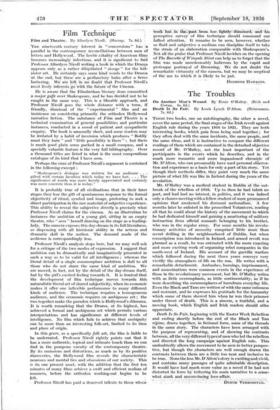Film Technique -
parallel in the contemporary reconciliations between men of letters and Hollywood. _ The hectic -vitality of American films becomes increasingly infectious, and it is significant to find
Professor Allardyce -Nicoll wy#iag a book in which the Drama appears only as a rather dilapidated " stooge " for the kid- Sister art. He certainly says some kind words to the Drama at the end, but these are #1,pprfunctiry balm after a fierce
battering. We ate 'lift Tif doubt that Professor Nicoll's most lively interests go with the future of the Cinema. .
He is aware that the Elizabethan literary dons committed a major gaffe over Shakespeare, and he has decided not to be caught in the same way. This is a likeable approach, and Professor Nicoll pies the whole distance with a terse, if friendly, dismissal of the " experiniental " film and an insistence on considering primarily the orthodox Hollywood
narrative fiction. The substance of Film and Theatre is a technical examination of general possibilities and particular
instances, conducted in a mood of patient and sympathetic enquiry. The book is unusually short, and some readers may be irritated by a habit of inversion which produces " Boldly must they turn " and "little possibility is there" ; but there is much good plain sense packed in a small compass, and a specially valuable feature is the very full bibliography. Over
a thousand titles are listed in what is the most-compendious
catalogue of its kind that I have seen. - - Perhaps the crux of Professor Nicoll's argument is contained in the following excerpt : " Shakespeare's dialogue was written for an audience . . gifted with certain faculties which today we have lost. . . . The significance of words was more keenly appreciated and certainly was more concrete than it is today." -
It is probably true of all civilisations that in their later stages they lose the gift of spontaneous response to the formal objectivity of ritual, symbol and image, preferring to seek a direct participation in the raw material of subjective experience.
This ability to reveal the subjective directly is precisely what Professor Nicoll claims for the cinema. As an illustration he
instances the anibiticin of a young girl, sitting in an empty theatre, who "-sees " herself dancing on the stage as a leading- lady. The camera exposes this day-dream in its full literalness, so dispensing with all histrionic ability in the actress and dramatic skill in the author. The demand made of the audience is correspondingly less.
Professor Nicoll's analysis stops here, but we may well ask for a critique of the two modes of expression. I suggest that ambition can be dramatically and imaginatively presented in such a way as to be valid for all intelligences ; whereas the literal detail of a single commonplace ambition is dull to all -those who do not share the same kind of ambition. We -are moved, in fact, not by the detail of the day-dream itself, but by the girl's excited feeling towards it. It is ironical that the development of film technique moves towards this naturalistic literal art of shared subjectivity, when its economic makes it offer one inflexible performance to many different kinds of audience. The technique requires a homogeneous audience, and the economic requires an ambiguous art ; the two together make the paradox which is Hollywood's dilemma. it is worth remarking that the Drama, at its highest, has achieved a formal and ambiguous art which permits various interpretations and has significance at different levels of intelligence. No film which fails to achieve that ambiguity can be more than an interesting folk-art, limited to its time and place of origin.
In this genre, as a specifically folk art, the film is liable to be underrated. Professor Nicoll rightly points out that it
has a more authentic, topical and intimate touch than we can find in the pompous vacuity of the contemporary theatre.
By its omissions and distortions, as much as by its positive discoveries, the Hollywood film reveals the characteristic neuroses and mental tics and obsessions of our society. This is its one present asset, with the addition that the first -ten minutes of many films achieve a swift and efficient realism of manners, before the orthodox working-out begins to be felt.
Professor Nicoll has paid a deserved tribute to those whose
and -his perceptive survey of film technique should command our fullest attention. It remains to be seen, however, whether so fluid and subjective a medium can discipline itself to take the strain of an elaboration comparable with Shakespeare's. Not all the praise that Professor Nicoll lavishes on the opening of The Barretti of Wiinpok Stied can help us to forget that the film was made unredeemably ludicrous by the vapid and grotesque portrayal of -Browning, .We do not . doubt • the remarkable virtuosity of the camera, but we may be sceptical of the use to which it is lflcelY to be put.
I$ESMOND HAVIWINS.










































 Previous page
Previous page